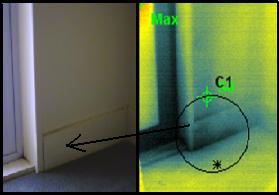Here’s an interesting question that we get asked alot…
“Can a house built with a cavity system and treated timber framing leak?” Yes it can.
Please be aware that all homes leak at some stage… both brand new and old homes. You can either have internal or external leaking problems in the home, no matter what year it was built, and if it has a cavity or not.
Here’s an example of both types…
Internal: Some new builds will leak the very first time a tap is turned on. We have been called out to plenty of jobs where a plumber hasn’t joined/glued a pipe correctly behind the wall and water has saturated carpets and external walls directly onto the treated timber framing (Normally H1.2 or above).
External: Recently we inspected a house in Albany, Auckland using thermal imaging and moisture testing equipment. The house was signed off in 2008 and had a 40mm polystyrene cladding on a 20mm cavity. The potential buyer was confident the home should be fine because it was required to have a cavity and treated timber. Wrong! The window joinery had failed and the timber frame was absolutely saturated in some sections of external wall.
How can a new home leak? When the weather turns from hot to cold, you then get expansion and contraction within the building envelope… and ‘things’ move and settle… and this can cause problems. The house itself also needs to settle and slight movement can take place… and then of course you have sub standard tradespeople who didn’t pay attention to details such as sealing off area where water can get into the walls… especially with wind driven rain! All these little factors combined can add up to some serious water damage to the property (Preferrably not your house, or the one you’re about to buy).
If you are prepared to spend anywhere from $1 – $ 1,000,000+ on a property, then you should get a leak test done regardless of the price tag and year it was built. Even if we aren’t the company you select to do the job, get it done regardless of the situation… for your own peace of mind (Read this first before selecting any other company).
When it comes to buying a house and pre-purchase inspections etc, the reality is that we are in New Zealand and it rains alot (We wouldn’t be having this conversation if you were looking at a home in the Mojave Desert)… where there is rain, there are leaks. It’s your risk at the end of the day, so we can only tell you about our past experiences with home buyers getting absolutely stung… and plenty of them have been people with experience in the real estate game.








